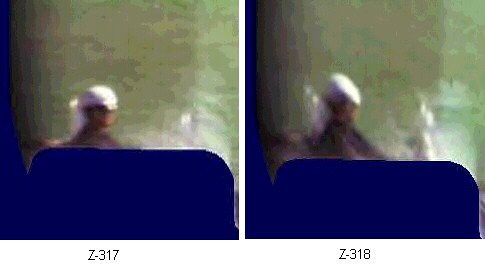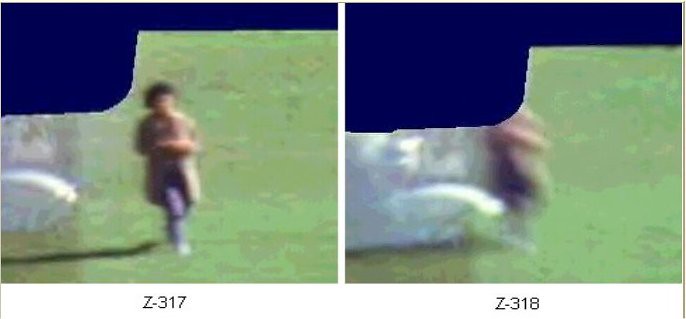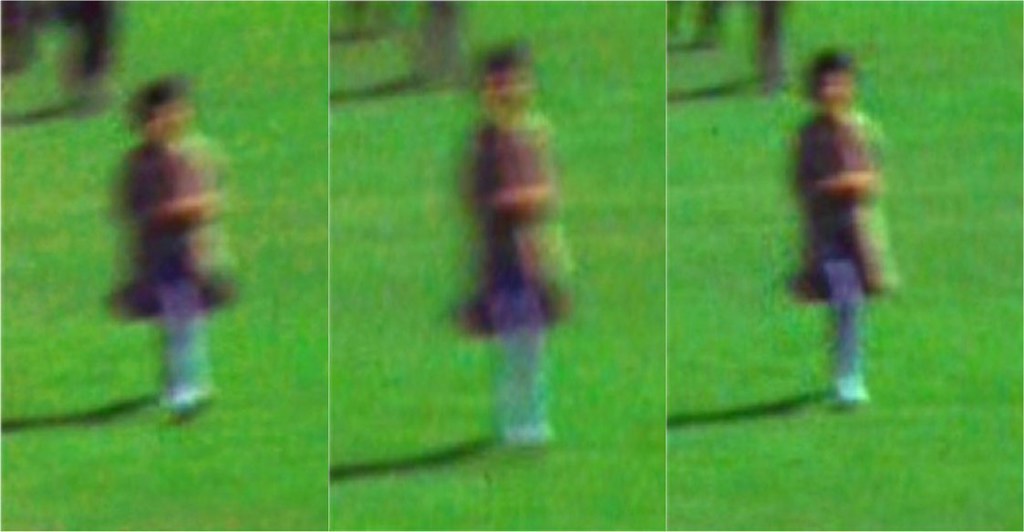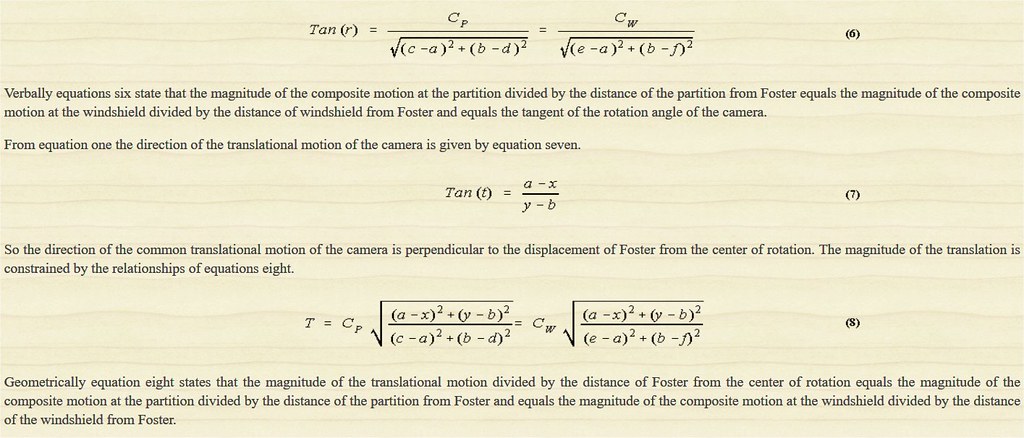|
|
Post by Herbert Blenner on Jan 15, 2019 12:55:55 GMT -5
Deciphering Kennedy's Movements
by Herbert Blenner | Last Updated on March 5, 2014
A frame-by-frame analysis of Kennedy's mechanical reactions to the fatal shot reveals details missed by viewing the motion picture.
The frames on this page are cropped to reduce vertical and horizontal panning errors. Although this adjustment enables the eye to observe otherwise obscured details, it leaves errors due to rotation of the camera unchanged. As a result we observe the illusion of a violently rocking limo.
Closer examinations of these frames reveal another illusion. Occasionally a solid object appears to change shape. A blur always accompanies this geometric distortion and suggests a localized buckling of film or other material caused the apparent change in shape.
frames Z311-312
Although Z311 and Z312 precede the head shot, they have importance for another reason. They show all occupants moving at the same speed as the limo. This observation discredits claims that braking of the limo affected motion of its occupants immediately before the head shot.
Without doubt, Z312 and Z313 are the main events of the Zapruder film. President Kennedy was the sole occupant to show a change in position.
As Kennedy's head moved forward, it rotated downward. Both these motions are consistent with a force from a bullet striking the rear of his head.
However, the absence of leftward spin conflicts with the medical evidence that shows the missile track confined to the right side of Kennedy's head.
The dramatic movements between Z312 and Z313 nearly reverse on Z313 and Z314. This abrupt reversal shows a second force acted on Kennedy's head about one frame after the first force set it into motion
frames z 313 -314
If spinal joints restrained farther movement of Kennedy's head then inertia would have transferred motion to his upper torso. In this case Kennedy's back would hunch forward and rotate downward with about one-fifth the speed of the head alone. Detecting such a slow movement is problematical since its duration was too brief to allow examination of following frames.
Z314 and Z315 show a rapid movement of Kennedy's head. It moved rearward and rotated upward. During this reverse head snap Kennedy's torso moved backward and rotated upward. However, the head did not move as far back as possible while the torso began its rearward motion.
frames Z315-316
The positions of Kennedy's head relative to his torso on Z315 and Z316 remained essentially unchanged. By contrast his torso rotates through a larger angle than on the Z314 and Z315.

frame z 317
Kennedy's head and torso continued moving as a single object on Z316 and Z317. As Kennedy rotated from a leaning toward a vertical position, gravity opposed this movement. After passing the vertical, gravity would have acted to increase the angular speed of his backward movement until the rear of the seat restrained motion.
|
|
|
|
Post by Herbert Blenner on Jan 15, 2019 12:56:40 GMT -5
One Step Backwardby Herbert Blenner | Posted Nov.6,2002 / Expanded Feb.10,2015Frames Z-311, Z-312, Z-314 and Z-315 show Toni Foster's right foot smoothly traveling forward. However, including Z-313 in the sequence produces a jerky motion and shows that the abbreviated sequence has no time for a step between Z-312 and Z-314. This deficiency applies equally to a blurred intermediary such as Z-313 or to a clear intermediate frame.This sequence begins with Toni Foster taking a step forward on Z-311 and Z-312. Foster had her left foot on the ground and her raised right foot somewhat forward. The following pair of frames, Z-312 and Z-313, show the previously forward moving right foot moved backward. Z-313 shows Tony Foster standing with both feet on the ground and her ankles nearly knocking. When examining frame Z-313 notice, the orientation of Tony Foster mismatches her alignments on the preceding and following frames. Toni Foster's reported motions on frames surrounding Z-313 are physical evidence of alteration. The film shows she was moving, stopped for one frame then continued her gait. These changes in speed occurred in around one frame period. They represent an acceleration of sizable magnitude, namely eighteen times her change in speed. Newton's law of motion relates force, F, to mass, m, times acceleration, a. By using the concept of weight, W, we can replace the mass by weight divided by the acceleration of gravity, G. F = (m)(a) = ( W / g )( a ) The acceleration of Toni Foster was eighteen times her change in speed, ΔV. Expressing ΔV in ft/sec, a = 18 ΔV ft/sec2 and using g = 32 ft/sec2 give F = 9/16 W (ΔV). For a moderate pace of 4 ft/sec, the Zapruder film reports Toni Foster exerted a force of 2.25 times her body weight. Further complications arise when we consider this film shows Toni Foster's feet nearly directly below her torso. This position frustrated use of her powerful leg muscles. Z312-Z314 Toni appears to move: right foot - 2 feet down - then right foot again. As expected the partition between the operator and passenger compartments of the limousine moves the same distance to the right from one frame to the next when the sequence is viewed with Z-313.This inclusion of Z-313 to show reasonable motion of the massive limo and the earlier omission of the same frame to show realistic movement of Toni Foster exposes our copy of the Zapruder film as a composite.
|
|
|
|
Post by Herbert Blenner on Jan 15, 2019 12:59:19 GMT -5
Medical Evidence Conflicts with Zapruder Filmby Herbert Blenner | Posted September 27, 2003A bullet wounding the right side of Kennedy's head would have produced spinning that is clearly absent from the Zapruder film.
The Warren Commission reported a bullet entered the right rear of President Kennedy's head, disrupted the right cerebral hemisphere and shattered the right side of his skull upon exiting.
Source: Warren Commission Report, page 19
"President Kennedy was first struck by a bullet which entered at the back of his neck and exited through the lower front portion of his neck, causing a wound which would not necessarily have been lethal. The President was struck a second time by a bullet which entered the right-rear portion of his head, causing a massive and fatal wound."
Source: Warren Commission Report, page 48
"At 12:30 p.m., c.s.t., as the President's open limousine proceeded at approximately 11 miles per hour along Elm Street toward the Triple Underpass, shots fired from a rifle mortally wounded President Kennedy and seriously injured Governor Connally. One bullet passed through the President's neck; a subsequent bullet, which was lethal, shattered the right side of his skull."
Experts from various fields examined the medical evidence and the photographic records. These specialists had the technical training to recognize a serious conflict, namely a bullet from the rear acting exclusively on the right side would have spun the head leftward as it rotated downward.
Source: CE 391, page 1
"Following formalin fixation the brain weighs 1500 gms. The right cerebral hemisphere is found to be markedly disrupted. There is a longitudinal laceration of the right hemisphere which is para-sagittal in position approximately 2. 5 cm. to the right of the of the midline which extends from the tip of the occipital lobe posteriorly to the tip of the frontal lobe anteriorly. The base of the laceration is situated approximately 4. 5 cm. below the vertex in the white matter. There is considerable loss of cortical substance above the base of the laceration, particularly in the parietal lobe. The margins of this laceration are at all points jagged and irregular, with additional lacerations extending in varying directions and for varying distances from the main laceration. In addition, there is a laceration of the corpus callosum extending from the genu to the tail. Exposed in this latter laceration are the interiors of the right lateral and third ventricles.
When viewed from the vertex the left cerebral hemisphere is intact. There is marked engorgement of meningeal blood vessels of the left temporal and frontal regions with considerable associated sub-arachnoid hemorrhage. The gyri and sulci over the left hemisphere are of essentially normal size and distribution. Those on the right are too fragmented and distorted for satisfactory description."
Comparable spinning and rotating accelerations would accompany a mean wound track less than two inches from the right and at the top of the head. Lowering the mean wound track location while keeping distance from the center fixed would make the spinning larger than the rotating acceleration. Justification for these above remarks appears under the title of "Modeling the head as a cylinder."
Contrary to expectations, the Zapruder film shows an abrupt downward rotation of the head without any observable leftward spinning. Clearly something was rotten in Washington.
|
|
|
|
Post by Herbert Blenner on Jan 15, 2019 12:59:56 GMT -5
Modeling the head as a cylinder
by Herbert Blenner | Posted September 27, 2003

The angular acceleration of the head, A, is the torque, N, divided by the moment of inertia, I. In general A = N / I. Hence the ratio of spinning to rotating accelerations becomes
As / Ar = ( Ns / Nr ) ( Ir / Is ).
Taking the head as a cylinder of height, H, and radius, R, we get 1 / 3 m H2 + 1 / 4 m R2 for the moment of inertia, Ir, belonging to the downward rotation. Correspondingly the moment of inertia, Is, associated with spin is 1 / 2 m R2. Using these moments to simplify the ratio of accelerations yields
As / Ar = 1 / 6 ( Ns / Nr ) ( 3 + 4 H2 / R2).
Typically H = 3 R for a well proportioned human head and neck extension. Hence the ratio of accelerations becomes
As / Ar = 6.5 Ns / Nr.
A wound track caused by a force, F, at a distance h from the rotational joint of the head yields a torque of Nr = F h. Concurrently a force, F, acts at a distance r from the spin axis of the head and gives Ns = F r. Simplifying produces
As / Ar = 6.5 r / h.
|
|
|
|
Post by Herbert Blenner on Jan 15, 2019 13:00:39 GMT -5
Motion Blur Analysisby Herbert Blenner | Posted January 25, 2004 Too often people ignore blurred frames of the Zapruder film. By recognizing the characteristics of various blurs they can obtain valuable information. In fact a blur caused by a rapidly moving object conveys more information than a clear frame.
Two features on frames Z324 and Z325 show blurs. They are the partition between operator and passenger compartments and the small white object immediately above the head of President Kennedy. Viewing following frames reveals that white object as the tip of the gloved hand of Mrs. Kennedy.
 
frames z324 - 325
Stepping from frame Z324 to Z325 shows two changes. The partition becomes clearer and the hand becomes blurrier. A closer examination shows most images on frame Z324 are blurrier than on frame Z325. Further the blurrier images show lateral streaking. These characteristics show movement of the camera with respect to the incoming light during exposure caused the blurring. By contrast, the movement of Mrs. Kennedy's hand by a few inches between frames Z324 and Z325 shows intrinsic motion as the cause of its increased blurriness.
Frames Z325 and Z326 show Mrs. Kennedy is swiping her hand from the left side to the rear of the President's head. As she swings her hand, its direction of motion moves away from the plane of view and toward the line of sight. By frame Z326, Mrs. Kennedy's hand is speeding toward the camera and its motion causes less blurring. This observation illustrates another characteristic of blurs caused by moving objects. Namely the components of their velocity lying in the plane of view cause blurring.
A lesser movement of the camera during exposure accounts for most objects becoming clearer on frame Z326.
 
frames z326 - 327
Having completed the left to rear movement, Mrs. Kennedy starts lowering her hand. This change in direction of her hand increases the downward component of its velocity. Not surprisingly more blurring accompanies the considerable downward speed of Mrs. Kennedy's hand as shown by frame Z327.
A blur caused by a rapidly moving object enables calculation of two components of its velocity. Usually the uncertainty in position due to blurring places an upper bound on the plane of view distance moved by an object during exposure. Knowing the exposure time permits calculation of the upper limit of two components of the object's velocity. This technique is especially valuable in evaluating brief motions such as Kennedy's forward and backward head snaps
|
|
|
|
Post by Herbert Blenner on Jan 15, 2019 13:01:10 GMT -5
Double Exposure
by Herbert Blenner | Posted March 8, 2010
Motion blur analysis shows that Z-318 is a composite of images photographed by cameras with differing motions while comparison of Z-317 with Z-318 disallows the images of Toni Foster as consecutive.
Z-317 shows three whitish spots on top of the partition between the operator and the passenger compartments of the limousine. A strong motion blur on Z-318 transformed these spots into three diagonal streaks.

Figure 1 - Motion Blur of the Partition
A clockwise rotation of the camera about a center of rotation below and to the right of the diagonal streaks could have produced this motion blur of Z-318. Alternately a counterclockwise rotation of the camera about a center above and to left of the diagonal streaks would explain this motion blur. In both cases the center of rotation would be along a line perpendicular to the direction of the diagonal streaks. The strength or the relative stretching of the blurred object would be proportional to distance of the object from the center of rotation. The two preceding comments describe the characteristic features of a rotational motion blur.
A translational motion of the camera down and to the right during exposure of Z-318 would have transformed the three whitish spots of Z-317 into the three diagonal streaks. Under these conditions the translational motion of the camera would have elongated all objects to the same extent and directed opposite of the camera’s movement.

Figure 2 - Motion Blur of the Windshields
Z-317 shows the windshields of two motorcycles. One windshield appears just behind the officer’s helmet and the second windshield is in front of the officer. Each windshield has a pair of nearly horizontal highlights. The motion blurs of Z-318 diagonally transform these highlights similar to the transformation of the whitish spots on the partition into diagonal streaks.
The motion blur of Z-318 changes the shape of the officer’s helmet. However, neither the extent nor the direction of the motion blur is readily discernible. So the highlights of the windshields are the chosen details for measurement of the motion blurs.
The direction of the diagonal streaks near the lower-right of Z-318 nearly coincide with the direction of the motion blurred highlights at the lower-left side. This near coincidence of directions of motion blurs near opposite sides of the Z-318 is decisive evidence that the camera movement during exposure was predominantly a translation.

Figure 3 - Focus Blur of Toni Foster
Z-317 shows the forearm of Toni Foster resting horizontally across her mid section. The shape of the brighter portion of the arm is roughly rectangular. The strong diagonal motion blur on Z-318 that affected the partition and the windshields should transform the rectangle into an irregular hexagon resembling a quadrilateral. However, Z-318 shows the arm with practically the same shape and size as on Z-317. This failure of the strong translational motion blur to affect all objects exposures Z-318 as a composite.
Frames Z-317 and Z-318 portend that the forearm of Toni Foster rotated approximately 30 degree in 1/18 second. Neither frame shows a rotational motion blur of the arm. So this pair reports that the forearm accelerated from rotational rest, reached a maximum angular speed then decelerated to rotational rest during the 1/36 second interval between the two exposures. These humanly impossible motions expose the images of Toni Foster on Z-317 and Z-318 as not chronologically ordered. |
|
|
|
Post by Herbert Blenner on Jan 15, 2019 13:01:16 GMT -5
Appendix 1 - Computer Generated Motion Blur of Toni Foster
On the untouched Z-317, three objects are useful in evaluating the effects of a diagonal motion blur. These objects are the whitish square at the bottom of Foster’s right leg, the shape of her upper head and the roughly rectangular arm.

Paint Shop Pro 8.0 generated this translational motion blur of Toni Foster. This simulated image shows that the diagonal motion blur changed shapes of her features. In particular the motion blur diagonally elongated the whitish square at the bottom of the left foot. This change is reminiscent of the transformation of the whitish spots on the partition into elongated streaks. The change in shape of Foster’s head is similar to the change in shape of the officer’s helmet. However, the blurring of the simulated arm of Toni Foster is strikingly different from the shape of the arm on Z-318. Further Z-318 show two white spots representing each foot of Toni Foster whereas the simulated image shows only one foot. A careful comparison of the Z-317 with Z-318 reveals that the positions of Foster’s legs on Z-318 do not correspond with their positions on Z-317.
|
|
|
|
Post by Herbert Blenner on Jan 15, 2019 13:01:23 GMT -5
|
|
|
|
Post by Herbert Blenner on Jan 15, 2019 13:02:27 GMT -5
What a Difference a Frame Makesby Herbert Blenner | Posted August 14, 2004Two frames of the Zapruder film show an uncharacteristic movement of President Kennedy and the eruption of tissues from the right front of his head. These frames are Z330 and Z331.
Frame Z329 shows the positions of the Kennedys and the orientation of the limousine. This information is necessary to establish movements of these subjects immediately before the motions reported by frames Z330 and Z331.
 
Frames Z329 and Z330
Z330 shows the rear of the limousine appeared to move toward the viewer as its front moved away. These changes show that the limousine was rounding a curve.
A careful comparison of the positions of the Kennedys show changing perspective due to the curving limousine caused part, if not all, of their apparent motion. Despite cause this motion is the standard for evaluating uncharacteristic movements of President Kennedy on the subject frames.
Blur of Z331 prevents saying whether Z330/Z331 show a comparable or somewhat smaller motion of Mrs. Kennedy. However, the magnitude of the change in President Kennedy's position overcomes the blur. Without doubt the Zapruder film reports a forward head snap with upper torso motion.
 
Frames Z330 and Z331
Z331 shows tissues and perhaps fluids erupted from President Kennedy's head and obscured its shape.
On Z332 a vertical motion blur elongates the shape of Mrs. Kennedy's head. This distortion shows how an unaltered head of the President would appear. In sharp contrast with the minor aberration of Mrs. Kennedy's head, the grossly mis proportioned dimensions of the President's head show that a catastrophic change had occurred. Following frames of the Zapruder film show the reality and permanence of this change.
|
|
|
|
Post by Herbert Blenner on Jan 17, 2019 15:31:32 GMT -5
Conclusions
Frames Z330 and Z331 show that President Kennedy's head moved with a nodding motion. This compound motion is evidence of a mechanical reaction to a head shot from the rear.
Blur of Z331 obscures recognition of a head spin. However, later frames show no transfer of spin momentum from the head to the torso. This infers a shot acting within inches of a diameter of the head.
The relative scarcity of ejectra is consistent with a second bullet transiting a head whose previously fractured skull contained diminished contents.
Bullets accelerate victims during transit. After the bullet stops within or exits, the acceleration ceases and an unrestrained victim continues moving with a constant speed. These considerations place the time of impact before Z331. The absence of a motion blur of President Kennedy's head on the preceding frame limits the time of impact toward the end or after Z330.
Although the torso movement is slow compared with the head snap, it represents a considerable increase in momentum imparted by a slowing bullet. In fact a minor movement of the torso represents a gain of more momentum than possessed by a M-C bullet.
Using the overlay method to compare these later copies of Z329 to Z332 with frames published by the WC show agreement of contents with one minor exception in the sprocket area of Z331. Apart from this unsurprising discrepancy, frames Z329 to Z332 present a strong case for a second head shot. [/p]
|
|


























